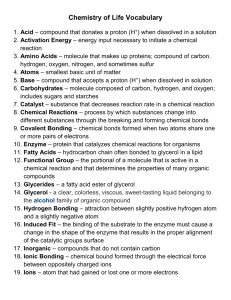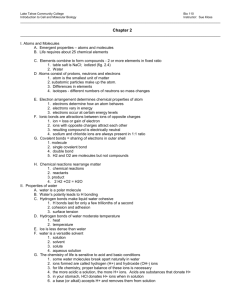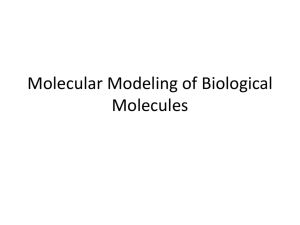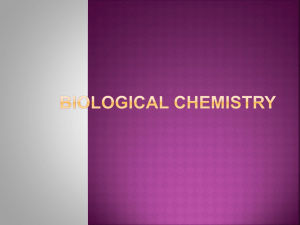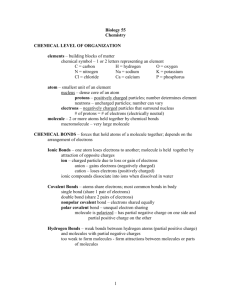Chapter 4 Need to Know List
advertisement
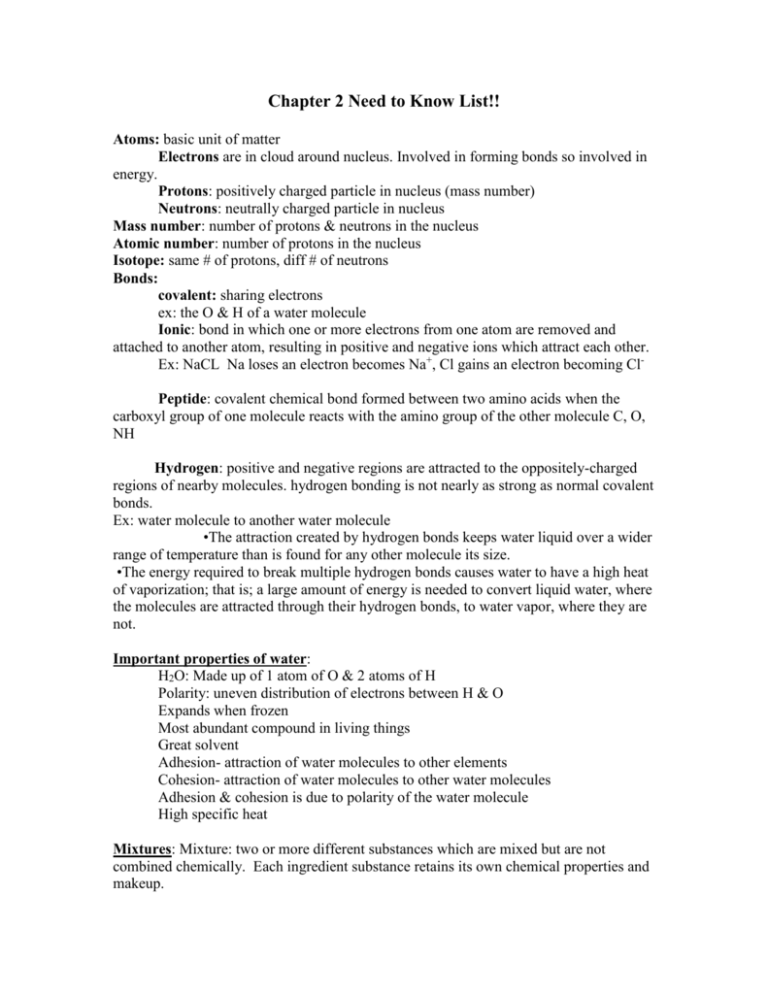
Chapter 2 Need to Know List!! Atoms: basic unit of matter Electrons are in cloud around nucleus. Involved in forming bonds so involved in energy. Protons: positively charged particle in nucleus (mass number) Neutrons: neutrally charged particle in nucleus Mass number: number of protons & neutrons in the nucleus Atomic number: number of protons in the nucleus Isotope: same # of protons, diff # of neutrons Bonds: covalent: sharing electrons ex: the O & H of a water molecule Ionic: bond in which one or more electrons from one atom are removed and attached to another atom, resulting in positive and negative ions which attract each other. Ex: NaCL Na loses an electron becomes Na+, Cl gains an electron becoming ClPeptide: covalent chemical bond formed between two amino acids when the carboxyl group of one molecule reacts with the amino group of the other molecule C, O, NH Hydrogen: positive and negative regions are attracted to the oppositely-charged regions of nearby molecules. hydrogen bonding is not nearly as strong as normal covalent bonds. Ex: water molecule to another water molecule •The attraction created by hydrogen bonds keeps water liquid over a wider range of temperature than is found for any other molecule its size. •The energy required to break multiple hydrogen bonds causes water to have a high heat of vaporization; that is; a large amount of energy is needed to convert liquid water, where the molecules are attracted through their hydrogen bonds, to water vapor, where they are not. Important properties of water: H2O: Made up of 1 atom of O & 2 atoms of H Polarity: uneven distribution of electrons between H & O Expands when frozen Most abundant compound in living things Great solvent Adhesion- attraction of water molecules to other elements Cohesion- attraction of water molecules to other water molecules Adhesion & cohesion is due to polarity of the water molecule High specific heat Mixtures: Mixture: two or more different substances which are mixed but are not combined chemically. Each ingredient substance retains its own chemical properties and makeup. Solutions: Solute the substance that is dissolved Solvent- the reagent in which the substance is dissolved Solution- molecules are dispersed uniformly throughout the solvent Suspension- materials never settle to bottom of container Compound: chemical substance consisting of two or more different chemically bonded chemical elements, with a fixed ratio. pH scale: acids: release hydrogen ions H+, most chemically reactive ion, numbers 1-6 on pH scale bases: release hydroxide ions OH- , numbers 7-14 on pH scale the closer to 7 the weaker the acid or base mix a strong acid & strong base- neutral solution neutral-7 buffer: compound that prevents drastic changes in pH Carbon compounds: contain 4 valence electrons, can polymerize because C can bound to C to form long chains & rings Carbon can form very strong covalent bonds because it has 4 electrons in its outer shell ie. 4 covalent bonds Isotope: Atoms of the same element can have different numbers of neutrons; the different possible versions of each element Inorganic compounds: do not contain carbon, except CO2 belongs in this group Organic compounds: contain carbon, exception CO2 does not belong 4 groups of macromolecules (organic compounds) found in living organisms: carbohydrates lipids proteins nucleic acids Monomer: one unit Polymer: many monomers bonded through dehydration synthesis to create a complex macromolecule. Dehydration Synthesis: used to build polymers from monomers, lose H2O Hydolysis: used to separate a monomer from a polymer use H20 Carbohydrates: C6H12O6 ratio- 1:2:1 Simplest are monosaccharides or single sugars A dissacharride (2 single sugars) is formed by dehydration synthesis (loss of water) Polysaccharide- many monosaccharides put together, how living things store excess sugar Ex: glycogen for animals, cellulose & starch for plants Polymerization: forms complex carbohydrate molecules by joining monomers Isomer: same molecular formula but different arrangement or structural formul Lipids: composed of a fatty acid & glycerol waxy, oily organic compounds Store energy Form biological membranes Chemical messengers Saturated-every carbon atom joined to another carbon atom by a single bond Unsaturated- a carbon atom joined to another carbon atom by a double bond Lipids produce more energy than carbohydrates do Sterol- a type of lipid Most common is cholesterol Important in building cells & carrying messages Phospholipids-a type of lipid One part dissolves in water the other part doesn’t Important in forming cell membranes Proteins: organic compounds Contain nitrogen, carbon, oxygen, hydrogen Polymers of amino acids An amino acid has an amino group at one end (NH2) & a carboxyl(COOH) group at the other The amino acids form peptide bond with each other & form long chains Levels of organization: primary = sequence of AA’s Secondary= folding or coiling of the chain 1. Enzymes: Important in: regulating pathways Transferring information Lowering the start up energy of a reaction/ releasing energy Most enzymes are proteins Enzymes are specific for temp, pH, reaction Substrates bind to enzymes at its active site- must fit shape of enzyme Nucleic Acids: Contain carbon, hydrogen, nitrogen & phosphorus DNA-deoxyribonucleic acid RNA-ribonucleic acid Contain genetic information Reactions: Chemical reaction: bonds are broken & forms. Either absorb energy or release energy. The atoms are rearranged. Reactants: elements or compounds entering into the reaction Products: elements or compounds produced by a chemical reaction Activation energy: energy needed to get a reaction started Energy absorbing reaction needs more than energy releasing Catalyst: substance that speed up a reaction (lowers activation energy) Enzyme: proteins that act as biological catalyst in cells Regulated by: pH, temp (may denature) Substrate: reactants of enzyme-catalyzed reaction



